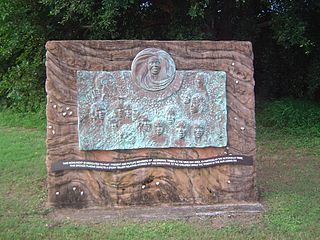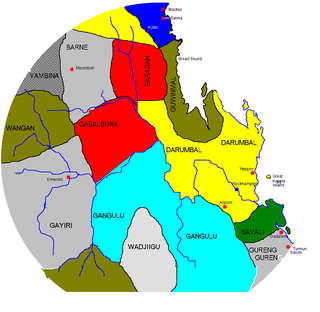
Palm Island is a locality consisting of an island group of 16 islands, split between the Shire of Hinchinbrook and the Aboriginal Shire of Palm Island, in Queensland, Australia. The locality coincides with the geographical entity known as the Palm Island group, also known as the Greater Palm group, originally named the Palm Isles.
The Jawoyn, also written Djauan, are an Australian Aboriginal people living in the Northern Territory of Australia. The Bagala clan are of the Jawoyn people.

Fantome Island is one of the islands in the Palm Island group. It is neighboured by Great Palm Island and is 65 km (40 mi) north-east of Townsville, Queensland on the east coast of Australia. The island is small with an area of 7.8 km2 (3.01 sq mi) and is surrounded by a fringing reef. The Djabugay (Aboriginal) name for this island is Eumilli Island.
The Bwgcolman is the self-assigned name for the Aboriginal Australians who were deported from many areas of the Queensland mainland, and confined in resettlement on Great Palm Island after the establishment of an Aboriginal reserve there in 1918, the Palm Island Aboriginal Settlement, and their descendants today. The name has also sometimes been applied to the island itself.

Wulguru, is an Australian Aboriginal language, now extinct, that was spoken by the Wulgurukaba people around the area around present day Townsville, Queensland, on the east coast of Australia. The range of Wulguru dialects known to have been around the area include two varieties mentioned from Palm Island, two from the Cleveland Bay area, and various dialects from Townsville.

The Jagera people, also written Yagarr, Yaggera, Yuggera, and other variants, are the Australian First Nations people who speak the Yuggera language. The Yuggera language which encompasses a number of dialects was spoken by the traditional owners of the territories from Moreton Bay to the base of the Toowoomba ranges including the city of Brisbane.
The Ngaro are an Australian Aboriginal group of people who traditionally inhabited the Whitsunday Islands and coastal regions of Queensland, employing a seafaring lifestyle in an area that archaeologically shows evidence of human habitation since 9000 BP. Ngaro society was destroyed by warfare with traders, colonists, and the Australian Native Police. The Native Police Corps forcibly relocated the remaining Ngaro people in 1870 to a penal colony on Palm Island or to the lumber mills of Brampton Island as forced labourers.

Great Palm Island, usually known as Palm Island, is the largest island in the Palm Islands group off Northern Queensland, Australia. It is known for its Aboriginal community, the legacy of an Aboriginal reserve, the Palm Island Aboriginal Settlement. The original inhabitants of the island were the Manbarra people, also known as the Wulgurukaba, who were removed to the mainland by the Queensland Government in the 1890s. The island is also sometimes referred to as Bwgcolman, which is the name given to the Aboriginal and Torres Strait Islander people from disparate groups who were deported from many areas of Queensland to the reserve in 1918, and their descendants.
The Dyirbal, also called Jirrbal, are an Aboriginal Australian people living in northern Queensland, both one tribe and a group of related contiguous peoples included under that label as the Dyirbal tribes. They live on the upper Murray river of the Atherton Tableland. Their name is used as a generic term to refer specifically to one of eight groups, the others being Yidinji, Ngadyan, Mamu, Girramay, Wargamay, Waruŋu and Mbabaɽam.
Mbabaram or Mbabaɽam, often referred to as the Barbaram people, are an Indigenous Australian people living in Queensland in the rainforests of the Atherton Tableland.
The Warruŋu, also known as the Warungu/Warrongo, were an Indigenous Australian people of the northern Queensland rainforest areas south of Cairns.
The Djiru, otherwise spelt Jirru, Are an Aboriginal Australian people whose traditional lands are along the coasts of Northern Queensland, mainly the area around Mission Beach.
The Djindubari, also written Jindoobarrie or Joondubarri, are or were an Aboriginal Australian people of southern Queensland, whose traditional lands were located on Bribie Island. They are thought to be a horde or clan of the Undanbi.

The Butchulla, also written Butchella, Badjala, Badjula, Badjela, Bajellah, Badtjala and Budjilla, are an Aboriginal Australian people of K'gari, Queensland, and a small area of the nearby mainland of southern Queensland.

The Gabulbarra people, also rendered Gabalbura, Gabalbara and Kabalbara, were an Aboriginal Australian people of an area in eastern Central Queensland, but there is little recorded information about them.
The Birri Gubba people, formerly known as Biria, are an Aboriginal Australian people of the state of Queensland.
The Warrgamay people, also spelt Warakamai, are an Aboriginal Australian people of the state of Queensland.
The Yangkaal, also spelt Yanggal, are an Aboriginal Australian people of area of the Gulf of Carpentaria in the state of Queensland.
The Biyaygiri, also known as Bandjin, were an Aboriginal Australian people of northern Queensland.

Palm Island Aboriginal Settlement, later officially known as Director of Native Affairs Office, Palm Island and also known as Palm Island Aboriginal Reserve, Palm Island mission and Palm Island Dormitory, was an Aboriginal reserve and penal settlement on Great Palm Island, the main island in the Palm Island group in North Queensland, Australia. It was the largest and most punitive reserve in Queensland.